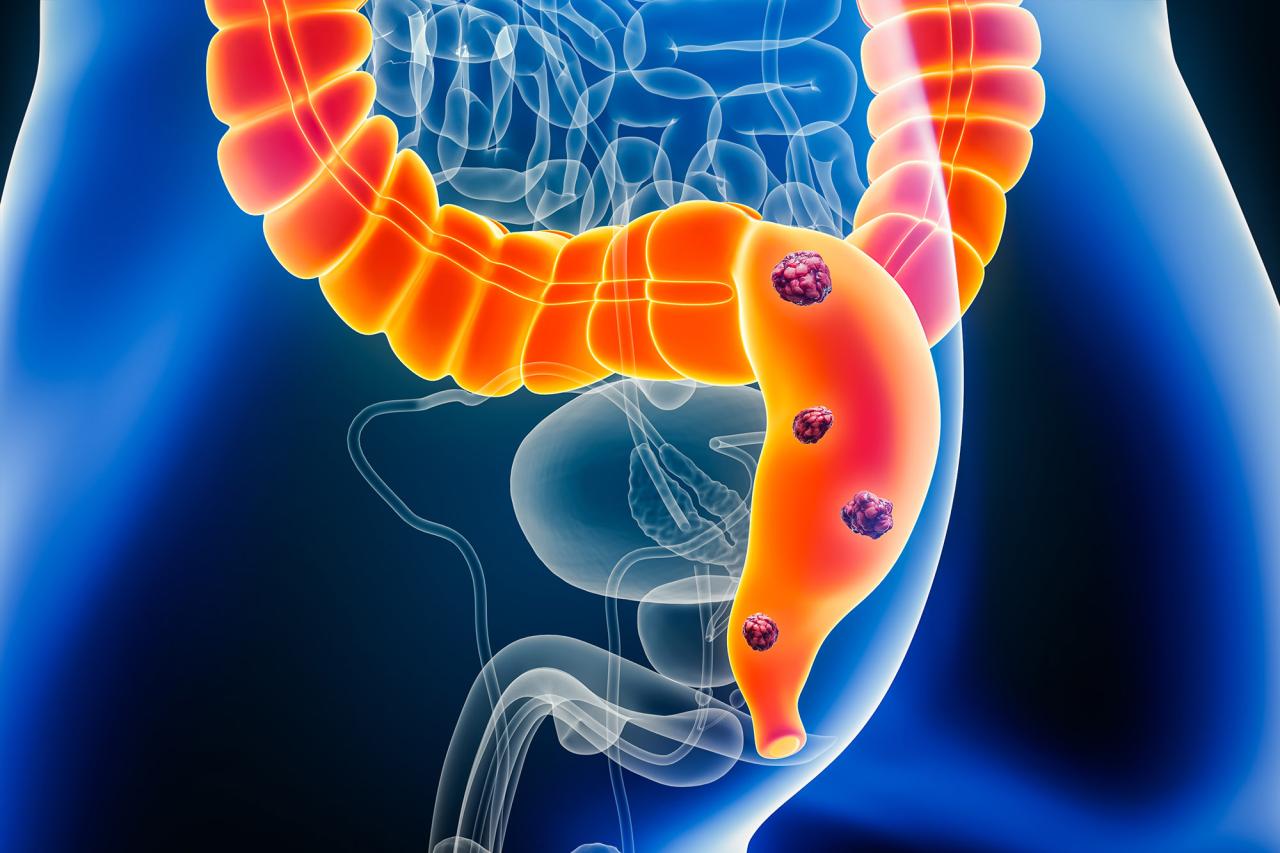
Is colorectal cancer the same as colon cancer? This question delves into the similarities and differences between these conditions, exploring their shared characteristics and distinct features. Understanding the nuances of each type is crucial for comprehending the complexities of diagnosis, treatment, and prevention.
Colorectal cancer encompasses both colon and rectal cancers, highlighting their close association. While often used interchangeably, subtle distinctions exist in their anatomical location, potential symptoms, and specific treatment approaches. This exploration will uncover these intricacies, providing a comprehensive overview of this critical health issue.
Defining Colorectal Cancer
Colorectal cancer, a collective term, encompasses cancers originating in the colon and rectum. Understanding this disease requires a nuanced look at the different components involved. This comprehensive exploration will delve into the specifics of each, their distinctions, and the crucial factors associated with diagnosis and treatment.Colorectal cancer is a complex disease, and its development is often a gradual process, starting with benign polyps that can grow into cancerous tumors over time.
Early detection is paramount, as it often allows for more effective treatment and better outcomes.
Anatomy and Types of Colorectal Cancer
The colon and rectum are contiguous parts of the large intestine, but distinct in their functions and susceptibility to different types of cancer. The colon, located above the rectum, is responsible for absorbing water and electrolytes from digested food. The rectum stores stool until it’s expelled from the body. This anatomical difference contributes to potential variations in symptoms and treatment.
Colon Cancer
Colon cancer develops within the colon’s lining. Its location influences the potential for symptoms to be subtle initially. Symptoms may include changes in bowel habits, such as constipation or diarrhea, blood in the stool, abdominal pain, and unexplained weight loss. These symptoms, however, can also be caused by other conditions, so early diagnosis is crucial.
Rectal Cancer
Rectal cancer originates in the rectum. Due to its location near the anus, symptoms might include bleeding, pain during bowel movements, and a feeling of incomplete emptying after bowel movements. Again, it’s essential to note that these symptoms can also be associated with other conditions.
Types of Colorectal Cancer
Colorectal cancer can be categorized based on its cellular characteristics. The most common types include adenocarcinomas, which arise from the glandular cells lining the colon and rectum. Other less common types, such as carcinoid tumors and lymphomas, exist but are less prevalent. Adenocarcinomas are further subclassified based on their microscopic appearance and growth patterns, which influence prognosis and treatment.
Comparison of Colon and Rectal Cancer
| Characteristic | Colon Cancer | Rectal Cancer |
|---|---|---|
| Anatomical Location | Colon (large intestine) | Rectum (lower portion of large intestine) |
| Risk Factors | Family history, inflammatory bowel disease, obesity, smoking, a diet low in fiber, high in processed foods, lack of physical activity. | Family history, inflammatory bowel disease, obesity, smoking, a diet low in fiber, high in processed foods, lack of physical activity, radiation exposure to the pelvis. |
| Symptoms | Changes in bowel habits, blood in the stool, abdominal pain, unexplained weight loss. | Bleeding, pain during bowel movements, feeling of incomplete emptying after bowel movements, changes in bowel habits. |
| Treatment Approaches | Surgery, chemotherapy, radiation therapy, targeted therapy. | Surgery, chemotherapy, radiation therapy, targeted therapy, and potentially, less invasive procedures like endoscopic resection. |
Early detection and treatment are crucial for improving outcomes in both colon and rectal cancer. Regular screening, particularly for those with risk factors, is highly recommended.
Understanding the Relationship: Is Colorectal Cancer The Same As Colon Cancer
Colorectal cancer, a term frequently used interchangeably with colon cancer, is actually a broader category encompassing both colon and rectal cancers. This close association, however, masks important distinctions in terms of location, risk factors, and treatment approaches. Understanding this nuanced relationship is crucial for accurate diagnosis, effective treatment, and informed patient care.The term “colorectal cancer” signifies that the cancer originates in the colon or rectum, two interconnected parts of the large intestine.
The colon is the longest part of the large intestine, while the rectum is the final, short section that connects to the anus. Cancer arising in either location shares common characteristics but also has unique features.
The Overlap and Interchangeability
The terms “colon cancer” and “colorectal cancer” are often used interchangeably in everyday conversation and even in some medical settings. This simplification is driven by the shared nature of the disease and the commonality of symptoms. However, this simplification can lead to a lack of awareness regarding the specific anatomical site of the cancer.
The Distinction: Colon vs. Colorectal
The scientific distinction between colon and colorectal cancer lies primarily in the anatomical location of the tumor. Colon cancer arises in the colon, while colorectal cancer can occur in either the colon or the rectum. This distinction is important for several reasons.
- Anatomical Differences: The colon and rectum have slightly different cellular structures and are subject to different environmental influences within the large intestine. This difference in environment can contribute to varied genetic mutations and development of cancers. For example, the higher concentration of bacteria in the colon can lead to specific types of inflammatory conditions associated with colon cancer.
- Risk Factors: While some risk factors overlap (such as a family history of colorectal cancer), certain factors are more strongly linked to either colon or rectal cancer. For instance, inflammatory bowel disease (IBD) has a stronger correlation with colon cancer than rectal cancer. This variation in risk factors allows for tailored screening and preventative measures.
- Staging and Treatment: The location of the cancer significantly impacts staging, treatment options, and prognosis. A tumor in the rectum might require different surgical approaches or radiation therapy protocols compared to one in the colon. For example, rectal cancers located higher in the rectum might be treated with different surgical techniques to avoid sphincter damage, which is crucial for bowel control.
Quick question: is colorectal cancer the same as colon cancer? Essentially, yes, colorectal cancer is colon cancer, but it also includes cancer of the rectum. While we’re on the topic of medical advancements, did you know a new clinical calculator could cut five years off breast cancer hormone therapy? This calculator could potentially significantly impact treatment plans.
So, while the specifics of colorectal/colon cancer treatment vary, understanding the similarities and differences is key for informed decisions about preventative measures and treatment.
Scientific Basis for the Distinction, Is colorectal cancer the same as colon cancer
The distinction between colon and colorectal cancer rests on a solid foundation of anatomical and biological considerations. The unique structure and function of the colon and rectum, coupled with variations in their microenvironment, contribute to the development of different types of cancers.
“The crucial distinction between colon and colorectal cancer is not just semantic but essential for precision in diagnosis, treatment, and prognosis.”
Quick answer: Colorectal cancer and colon cancer are often used interchangeably, but technically, colorectal cancer includes cancers of the colon and rectum. Understanding how communities like Howaa City prioritize health is key to tackling this issue. For example, howaa city gets healthy by focusing on preventative measures and early detection. This proactive approach can potentially reduce the risk of colorectal cancer significantly, and underscores the importance of ongoing research and community initiatives in health.
Understanding the specific location of the cancer within the large intestine allows for more precise risk assessment, treatment planning, and monitoring of the patient’s response to therapy. By recognizing the nuances of the relationship between colon and colorectal cancer, healthcare professionals can provide more targeted and effective care.
Similarities and Differences
Colorectal cancer, encompassing both colon and rectal cancers, shares significant overlapping characteristics. Understanding these similarities and differences is crucial for effective diagnosis, treatment, and patient care. This section will delve into the commonalities and distinctions between colon and rectal cancer, exploring treatment approaches and their variations.The overlapping characteristics and commonalities between colon and rectal cancers often make diagnosis and treatment strategies similar.
However, distinct features of each type require tailored approaches. The location and specific biological behavior of the cancer influence treatment protocols.
Overlapping Characteristics
Colon and rectal cancers, though distinct in origin, share fundamental similarities. Both are malignant tumors originating from the digestive tract, and their development often involves a progression from benign polyps to cancerous lesions. This progression is typically a slow process that allows for detection and intervention if monitored properly. Genetic mutations, environmental factors, and lifestyle choices contribute to the development of both types.
Clinical Presentation Comparisons
While both colon and rectal cancers can exhibit similar initial symptoms, such as changes in bowel habits, abdominal pain, or blood in the stool, the presentation can vary. Rectal cancers, situated closer to the anus, might exhibit symptoms such as bleeding from the rectum, changes in bowel habits, or a feeling of incomplete emptying. Colon cancers, originating higher in the colon, might present with similar symptoms but may take longer to show noticeable signs.
Early detection is key to successful treatment, emphasizing the importance of regular screenings.
Treatment Strategies
Colorectal cancer treatment is highly individualized, taking into account the cancer’s stage, location, and the patient’s overall health. Surgery is a cornerstone of treatment, often involving the removal of the affected portion of the colon or rectum. Chemotherapy is frequently used to shrink tumors and eliminate remaining cancer cells, and radiation therapy is sometimes incorporated to target residual disease.
Treatment Protocol Variations
Treatment protocols for colon and rectal cancers can differ based on the tumor’s location and stage. Rectal cancers, situated closer to sensitive structures, may necessitate more precise surgical techniques to minimize complications. The specific chemotherapy regimens, radiation protocols, and the timing of these treatments might vary. For instance, neoadjuvant chemotherapy, given before surgery, might be considered for more advanced rectal cancers to shrink the tumor and improve surgical outcomes.
Summary Table
| Characteristic | Colon Cancer | Rectal Cancer |
|---|---|---|
| Risk Factors | Family history, inflammatory bowel disease, diet low in fiber, smoking, obesity | Family history, inflammatory bowel disease, diet low in fiber, smoking, obesity, certain types of radiation exposure (less common than colon). |
| Symptoms | Changes in bowel habits, abdominal pain, blood in the stool, fatigue, unintended weight loss | Bleeding from the rectum, changes in bowel habits, feeling of incomplete emptying, pain in the rectal area, pain during bowel movements. |
| Treatment Options | Surgery (colectomy), chemotherapy, radiation therapy, targeted therapy. | Surgery (rectal resection), chemotherapy, radiation therapy, targeted therapy, neoadjuvant chemotherapy (sometimes). |
Risk Factors and Prevention

Colorectal cancer, a disease affecting the colon and rectum, is a significant health concern globally. Understanding the factors that increase risk and adopting preventive measures are crucial for reducing the incidence and improving outcomes. Proactive steps, including lifestyle modifications and early detection, play a vital role in mitigating the risk of this disease.
Risk Factors Associated with Colorectal Cancer
Several factors contribute to the development of colorectal cancer. A combination of genetic predisposition, lifestyle choices, and environmental exposures can increase an individual’s susceptibility. These factors can interact in complex ways, influencing the risk level for each person.
- Age: The risk of colorectal cancer increases significantly with age, as the risk rises with the accumulation of genetic and environmental factors over time.
- Family history: A strong family history of colorectal cancer or polyps significantly increases the risk. Individuals with a family history should be more vigilant about screenings and discuss their risk with healthcare professionals.
- Personal history of colorectal polyps: Having had colorectal polyps in the past is a significant risk factor. Polyps, abnormal growths in the colon or rectum, can sometimes develop into cancerous tumors if left untreated.
- Inflammatory bowel diseases (IBD): Conditions like Crohn’s disease and ulcerative colitis, which cause chronic inflammation of the digestive tract, increase the risk of colorectal cancer. Long-term inflammation can lead to cellular damage and increase the chance of cancerous changes.
- Diet: A diet low in fruits, vegetables, and fiber, and high in processed meats, has been linked to an elevated risk. Dietary choices influence the gut microbiome, which in turn plays a role in colorectal cancer development.
- Physical inactivity: A sedentary lifestyle is associated with a higher risk of colorectal cancer. Regular physical activity can help maintain a healthy weight and reduce inflammation.
- Obesity: Being overweight or obese increases the risk of developing colorectal cancer. Excess body fat can lead to chronic inflammation and hormonal imbalances that contribute to cancer development.
- Smoking: Smoking has been linked to an increased risk of several cancers, including colorectal cancer. The specific mechanisms by which smoking contributes to colorectal cancer development are still under investigation.
- Alcohol consumption: Excessive alcohol consumption is associated with a higher risk of colorectal cancer. The exact relationship between alcohol and colorectal cancer development is complex and not fully understood.
Lifestyle Choices in Colorectal Cancer Prevention
Adopting a healthy lifestyle can significantly reduce the risk of colorectal cancer. Dietary choices, physical activity, and avoiding tobacco and excessive alcohol consumption are vital components of a preventive strategy.
- Maintaining a healthy weight: Maintaining a healthy weight through a balanced diet and regular exercise can reduce the risk of colorectal cancer. Obesity is strongly associated with inflammation and hormonal imbalances that increase cancer risk.
- Eating a high-fiber diet: A diet rich in fruits, vegetables, and whole grains provides essential fiber, which promotes healthy digestion and can help reduce the risk of colorectal cancer. Fiber can also aid in maintaining a healthy weight.
- Regular physical activity: Engaging in regular physical activity can help maintain a healthy weight, reduce inflammation, and improve overall health. Exercise is a key component of a preventive strategy for various diseases, including colorectal cancer.
- Limiting processed meat consumption: Reducing intake of processed meats, such as bacon, hot dogs, and sausages, can help lower the risk of colorectal cancer. Processed meats often contain compounds that can potentially contribute to cancer development.
- Avoiding tobacco and excessive alcohol: Smoking and excessive alcohol consumption significantly increase the risk of colorectal cancer. Quitting smoking and limiting alcohol intake are crucial for reducing this risk.
Lifestyle Modifications for Colorectal Cancer Prevention
This table Artikels various lifestyle modifications and their potential impact on reducing the risk of colorectal cancer.
| Lifestyle Modification | Impact on Reducing Colorectal Cancer Risk |
|---|---|
| Maintaining a healthy weight | Reduces inflammation, improves hormonal balance, and lowers risk. |
| Regular physical activity | Helps maintain a healthy weight, reduces inflammation, and improves overall health. |
| High-fiber diet | Promotes healthy digestion, regulates bowel movements, and lowers risk. |
| Limit processed meat consumption | Reduces exposure to potential cancer-causing compounds. |
| Avoid tobacco and excessive alcohol | Significantly lowers risk by reducing inflammation and exposure to harmful substances. |
Importance of Screening and Early Detection
Regular screening for colorectal cancer is essential for early detection. Early detection allows for prompt intervention and treatment, often leading to better outcomes. This proactive approach can significantly improve the chances of successful treatment and recovery.
- Screening tests can detect precancerous polyps, which can be removed before they develop into cancer. Early detection is crucial to prevent cancer progression and improve survival rates.
- Early detection allows for prompt intervention, potentially preventing the need for extensive treatment. Early intervention improves the chances of successful treatment.
Colorectal Cancer Screening Methods
Different screening methods are available for colorectal cancer, each with its own benefits and drawbacks. The choice of screening method often depends on individual factors and medical recommendations.
| Screening Method | Description |
|---|---|
| Fecal occult blood test (FOBT) | Detects hidden blood in stool, indicating potential bleeding in the colon or rectum. |
| Fecal immunochemical test (FIT) | Detects blood in stool, often more sensitive than FOBT. |
| Colonoscopy | A procedure using a flexible tube with a camera to visualize the entire colon and rectum. |
| Sigmoidoscopy | A procedure using a flexible tube with a camera to visualize the lower part of the colon and rectum. |
| Virtual colonoscopy (CT colonography) | Uses X-rays to create images of the colon and rectum. |
Diagnostic Procedures
Uncovering colorectal cancer early is crucial for successful treatment. Accurate and timely diagnosis allows for personalized interventions and improved patient outcomes. This crucial step involves a combination of various procedures, each playing a specific role in identifying the presence and extent of the disease.Diagnostic methods for colorectal cancer encompass a range of procedures, progressing from initial screening to more invasive examinations if necessary.
The process often begins with a physical exam and patient history, followed by specific tests to pinpoint the problem and determine the extent of the disease. The goal is to pinpoint the exact location, size, and characteristics of any abnormalities detected.
Initial Screening and Risk Assessment
Initial screening and risk assessment are vital in identifying individuals at high risk of developing colorectal cancer. These procedures typically involve non-invasive methods and can detect precancerous polyps or early-stage cancers, allowing for timely intervention and potentially preventing the disease from progressing. A thorough history, including family history, lifestyle factors, and prior medical conditions, is collected. This information, combined with physical examination findings, helps determine the appropriate screening approach for each individual.
Colonoscopy
A colonoscopy is a common and highly effective procedure for visualizing the entire colon and rectum. A flexible tube with a camera (endoscope) is inserted through the rectum into the colon. This allows for direct observation of the lining, enabling the detection of polyps, tumors, or other abnormalities. During the procedure, any suspicious areas can be biopsied (small tissue samples are taken) for further analysis.
The images obtained during a colonoscopy provide valuable information for diagnosis and guide subsequent treatment plans.
Biopsy
A biopsy is a crucial procedure to confirm a suspected diagnosis. A small tissue sample is removed from the abnormal area for examination under a microscope. Pathologists analyze the tissue sample for cellular changes indicative of cancer or precancerous conditions. The results of the biopsy provide definitive confirmation of the diagnosis and help determine the stage and grade of the cancer.
This information is critical for planning appropriate treatment strategies.
Imaging Tests
Imaging tests, such as CT scans, MRI scans, and X-rays, play a significant role in evaluating the extent of colorectal cancer. CT scans provide detailed cross-sectional images of the abdomen and pelvis, enabling visualization of the size and location of the tumor and its possible spread to nearby lymph nodes. MRI scans offer high-resolution images, often used to assess the depth of tumor invasion and the extent of local spread.
X-rays, though less detailed than CT or MRI, can still be helpful in detecting large masses or obstructions. These tests are often used in conjunction with other diagnostic methods to gain a comprehensive picture of the disease.
Table of Diagnostic Tests
| Test | Purpose | Procedure | Results |
|---|---|---|---|
| Colonoscopy | Visualize the entire colon and rectum | Flexible tube with a camera is inserted into the rectum | Detection of polyps, tumors, or other abnormalities; biopsies can be taken |
| Biopsy | Confirm a suspected diagnosis | Small tissue sample is removed from the abnormal area | Cellular analysis; confirmation of cancer or precancerous conditions; staging and grading of the cancer |
| CT Scan | Evaluate the extent of cancer | Detailed cross-sectional images of the abdomen and pelvis | Tumor size, location, and spread to lymph nodes |
| MRI Scan | Assess the depth of tumor invasion | High-resolution images of the abdomen and pelvis | Tumor depth, local spread, and other relevant details |
| X-ray | Detect large masses or obstructions | X-rays of the abdomen and pelvis | Presence of large masses or obstructions |
Importance of Early Detection and Screening
Early detection significantly improves treatment outcomes for colorectal cancer. The earlier cancer is diagnosed, the greater the chances of successful treatment and potentially cure. Screening programs are designed to identify individuals at risk and detect precancerous polyps or early-stage cancers before they cause noticeable symptoms. This proactive approach can lead to more effective treatments, reducing the severity of the disease and improving patient survival rates.
Treatment Options and Outcomes

Colorectal cancer treatment approaches are multifaceted and tailored to the specific stage, location, and overall health of the patient. Success often hinges on early detection and prompt intervention, leading to improved outcomes. This section details the diverse treatment strategies available and their potential impacts.Effective treatment for colorectal cancer frequently involves a combination of therapies, each playing a critical role in achieving optimal outcomes.
Understanding the individual components and their potential side effects is crucial for informed decision-making.
Surgical Approaches
Surgical intervention is a cornerstone of colorectal cancer treatment. The type of surgery depends on the tumor’s location, size, and stage. Surgical procedures can range from minimally invasive techniques, such as laparoscopic surgery, to open procedures, which are necessary in some cases. Minimally invasive surgery often results in less pain, faster recovery, and smaller scars compared to open surgery.
In certain cases, a colectomy (removal of part or all of the colon) may be necessary. Furthermore, lymph node dissection, the removal of lymph nodes surrounding the tumor, is frequently performed to assess the extent of the cancer’s spread. The specific surgical approach is determined by the patient’s unique circumstances and the guidance of medical professionals.
Chemotherapy
Chemotherapy drugs target rapidly dividing cells, which includes cancer cells. These drugs can be administered intravenously or orally. The choice of chemotherapy regimen depends on the specific type of colorectal cancer, the stage of the disease, and the patient’s overall health. Common chemotherapy regimens include 5-fluorouracil (5-FU), leucovorin, and oxaliplatin. Side effects of chemotherapy can include nausea, vomiting, fatigue, hair loss, and mouth sores.
Managing these side effects is an important aspect of cancer care. The effectiveness of chemotherapy varies among patients and is often determined by factors like the patient’s response to the treatment and the tumor’s sensitivity to the drugs.
Radiation Therapy
Radiation therapy utilizes high-energy rays to damage cancer cells, often used to shrink tumors before surgery or to treat residual cancer after surgery. External beam radiation therapy directs radiation beams at the tumor from outside the body. Internal radiation therapy (brachytherapy) involves placing radioactive materials directly into or near the tumor. Side effects of radiation therapy can include fatigue, skin irritation, and digestive problems.
The extent and type of radiation therapy are carefully planned based on the specific needs of each patient.
Targeted Therapies
Targeted therapies are newer approaches that focus on specific molecular characteristics of colorectal cancer cells. These therapies target specific pathways or proteins involved in cancer growth and spread. Examples include monoclonal antibodies that block specific proteins, or drugs that inhibit the growth of blood vessels that feed tumors. The effectiveness of targeted therapies can vary, but they are often used in combination with other treatments like chemotherapy.
These therapies are more likely to be effective in specific types of colorectal cancers that have certain genetic markers. Understanding the patient’s specific genetic profile is essential for determining the most suitable targeted therapy.
Table Summarizing Treatment Options and Outcomes
| Treatment Option | Potential Effectiveness | Potential Side Effects | Outcomes (General Overview) |
|---|---|---|---|
| Surgery | High effectiveness in localized cancers; can remove the tumor and potentially cure the disease. | Pain, infection, bleeding, and scarring. | Improved survival rates and quality of life. |
| Chemotherapy | Effective in reducing tumor size and slowing cancer progression, particularly in advanced cases. | Nausea, vomiting, fatigue, hair loss, mouth sores. | Improved survival and symptom control. |
| Radiation Therapy | Effective in shrinking tumors before surgery or treating residual cancer. | Fatigue, skin irritation, digestive problems. | Tumor reduction and improved local control. |
| Targeted Therapies | Effective in cancers with specific genetic markers, can slow or stop tumor growth. | Fatigue, diarrhea, and skin rash. | Can improve survival in certain cases and reduce side effects of chemotherapy. |
Patient Experience and Support
Facing a colorectal cancer diagnosis is profoundly challenging. Beyond the medical aspects, patients grapple with a wide range of emotional and psychological reactions. Navigating treatment, managing side effects, and adjusting to a new normal requires significant support. This journey is often isolating, but understanding the experience and accessing resources can make a world of difference.
The Emotional and Psychological Impact
Colorectal cancer diagnosis can trigger a cascade of emotions, including anxiety, fear, sadness, and anger. Patients may experience uncertainty about their future, worry about loved ones, and grapple with feelings of isolation. These emotional responses are completely normal and a part of the human experience when facing a serious illness. The support of healthcare professionals, family, and friends is crucial in managing these complex feelings.
Quick question: is colorectal cancer the same as colon cancer? Basically, yes, but colorectal cancer encompasses colon cancer and cancer of the rectum. Speaking of health trends, did you see the new diet rankings? Apparently, the keto diet is trending lower, while the DASH diet is higher on the list of popular choices, according to keto ranked low dash ranked high on new diet list.
This is interesting, but regardless of the latest diet craze, it’s still important to understand the difference between the two types of cancer for better health outcomes. So, while the terms are often used interchangeably, colorectal cancer is the broader category.
Seeking professional counseling or therapy can also be invaluable in helping patients process their emotions and cope with the challenges ahead.
Navigating Treatment and Side Effects
The treatment for colorectal cancer can be demanding, with potential side effects that impact daily life. These can range from fatigue and nausea to changes in bowel habits and pain. Open communication with the healthcare team is essential for managing these side effects effectively. Understanding the potential side effects and developing coping mechanisms can help patients maintain their quality of life during treatment.
Access to Resources and Support Groups
A comprehensive network of support groups and resources is crucial for colorectal cancer patients. These groups offer opportunities for patients to connect with others facing similar challenges, share experiences, and find emotional support.
| Resource Type | Description |
|---|---|
| Support Groups | These groups provide a safe space for patients to connect with others who understand their experiences. They often offer opportunities for emotional support, practical advice, and shared coping strategies. Many are facilitated by trained professionals or volunteers. |
| Online Forums | Online platforms allow patients to connect with a wider community of individuals facing similar situations. They provide a space for sharing experiences, asking questions, and receiving encouragement. However, it is important to verify the reliability and credibility of information found online. |
| Cancer Centers | Cancer centers typically offer comprehensive support services, including support groups, counseling, and educational programs. These resources can provide invaluable assistance for patients and their families. |
| Patient Advocacy Organizations | These organizations actively advocate for the needs of cancer patients. They work to raise awareness, provide educational resources, and support policies that improve patient care. |
| Family Support Services | Supporting families is equally important. Family support services offer guidance, resources, and emotional support to those caring for a loved one with colorectal cancer. They help families navigate the emotional and practical challenges of the disease. |
The Importance of Patient Advocacy
Patient advocacy plays a significant role in shaping the colorectal cancer landscape. By sharing their experiences, raising awareness, and advocating for better treatment options and support systems, patients can make a tangible difference in the lives of others. Patient advocates often become powerful voices for change, ensuring that their experiences contribute to improved care and outcomes for all patients.
Illustrative Examples
Exploring real-life cases of colon and rectal cancer helps us understand the complexities of these diseases and how treatment decisions are made. These examples highlight the diverse ways cancer can manifest and the personalized approach needed for effective care.
Case Study: Colon Cancer
A 65-year-old male presented with persistent abdominal discomfort and changes in bowel habits. A colonoscopy revealed a malignant tumor in the sigmoid colon. The tumor was relatively small, and the patient’s overall health was good, with no significant comorbidities. The patient underwent a surgical resection of the affected segment of the colon, followed by adjuvant chemotherapy to reduce the risk of recurrence.
The patient made a full recovery and is currently cancer-free, five years post-surgery.
Case Study: Rectal Cancer
A 50-year-old female experienced bleeding and altered bowel movements. A rectal examination and subsequent imaging confirmed the presence of a rectal tumor. The tumor was located higher in the rectum, close to the anal canal, and posed a greater risk of complications during surgery. In this case, a combination of surgery and radiation therapy was deemed necessary to remove the tumor and minimize the risk of local recurrence.
The patient underwent a low anterior resection and subsequent radiation therapy. While the patient experienced some short-term discomfort, she is now cancer-free, three years after treatment.
Key Differences in Treatment Approaches
The treatment approaches varied between the two cases due to factors like tumor location, size, stage, and the patient’s overall health. Rectal cancer, often located closer to vital structures, may necessitate a more complex surgical procedure and potentially radiation therapy, which was not required for the colon cancer case. The patient with rectal cancer experienced some short-term discomfort, which was managed by supportive care.
Factors Influencing Treatment Decisions
Treatment decisions are influenced by several crucial factors, each individually and in combination:
- Tumor Location and Size: The precise location of the tumor within the colon or rectum is critical. Tumors closer to vital structures, like the anal canal in the rectum, require specialized surgical techniques and may benefit from additional therapies, such as radiation.
- Tumor Stage and Grade: The stage and grade of the cancer, determining the extent of the disease and the aggressiveness of the cancer cells, are critical considerations. Early-stage cancers might be treated with surgery alone, whereas more advanced cases might require a multi-modal approach.
- Patient’s Overall Health: Pre-existing medical conditions, age, and overall health status significantly impact treatment decisions. A patient with significant comorbidities might not be suitable for aggressive treatments, while a younger, healthier patient might tolerate more extensive procedures.
- Patient Preferences and Values: The patient’s preferences, understanding of the risks and benefits of different treatment options, and their personal values also play a crucial role. Open communication and shared decision-making are essential in ensuring the best possible outcomes.
Conclusive Thoughts
In conclusion, while colorectal cancer and colon cancer are closely related, understanding the distinction between them is vital. This detailed look at their similarities and differences, risk factors, diagnostic procedures, and treatment options empowers individuals to make informed decisions about their health. The discussion emphasizes the importance of early detection and proactive measures in managing this significant health concern.





